Simulation of Water–Energy–Food–Carbon Nexus in the Agricultural Production Process in Liaocheng Based on the System Dynamics (SD)
Abstract
1. Introduction
2. Materials and Methods
2.1. Study Area
2.2. Data Sources
2.3. Research Methods Carbon Emissions Accounting
2.4. System Dynamics
2.5. Model Building
2.5.1. Modeling
2.5.2. Main Equations
2.5.3. Model Validation
2.6. Scenario Setting
3. Results
3.1. Model Validation Results
3.2. Analysis of Trends in Agricultural Carbon Emissions
3.3. Analysis of Agricultural Forecast Development Under Each Scenario
4. Discussion
4.1. Impact of Different Scenarios on WEFC-Nexus System
4.2. Policy Implications
5. Conclusions
Supplementary Materials
Author Contributions
Funding
Institutional Review Board Statement
Informed Consent Statement
Data Availability Statement
Conflicts of Interest
References
- Assa, N.; Ma, R.; Li, J.; Luo, H.; Zhao, Q.; Tomka, J.; Zhang, M. Tackling climate change in agriculture: A global evaluation of the effectiveness of carbon emission reduction policies. J. Clean. Prod. 2024, 468, 142973. [Google Scholar] [CrossRef]
- Wang, J.H.; Sun, S.K.; Yin, Y.L.; Wang, K.X.; Sun, J.X.; Tang, Y.H.; Zhao, J.F. Water-Food-Carbon Nexus related to the producer-consumer link: A review. Adv. Nutr. 2022, 13, 938–952. [Google Scholar] [CrossRef]
- Zhang, P.Y.; He, J.; Pang, B.; Lu, C.P.; Qin, M.Z.; Lu, Q.C. Temporal and spatial differences in carbon footprint in farmland ecosystem: A case study of Henan Province, China. Chin. J. Appl. Ecol. 2017, 28, 3050–3060. [Google Scholar]
- Tian, Y.; Yin, Y. Re-evaluation of China’s Agricultural carbon emissions: Basic status, dynamic evolution and spatial spillover effects. Chin. Rural Econ. 2022, 03, 104–127. [Google Scholar]
- Yuan, X.; Hua, L.C.; Wen, L.J.; Hui, L.; Yan, L.Q.; Lin, K.Z.; Peng, Y.; Jiahui, L. Analysis of spatial and temporal characteristics and drivers of agricultural carbon emissions in China. Chin. J. Eco-Agric. 2024, 32, 1805–1817. [Google Scholar]
- Qian, F.K.; Wang, X.G.; Gu, H.L.; Wang, D.P.; Li, P.F. Characteristics of spatial and temporal divergence of agricultural carbon emissions in three northeastern provinces and its key driving factors. Chin. J. Eco-Agric. 2024, 32, 30–40. [Google Scholar]
- Zhou, Y.F.; Li, B.; Zhang, R.Q. Spatiotemporal evolution and influencing factors of agricultural carbon emissions in Hebei Province at the county scale. Chin. J. Eco-Agric. 2022, 30, 570–581. [Google Scholar]
- Cao, Y.L.; Ni, X.; Gong, H.Y. Influencing factors and decoupling effects of agricultural carbon emissions in the Yangtze river economic belt. Huanjing Kexue 2025, 46, 1535–1547. [Google Scholar]
- Liu, Y.; Xu, S.X. Study on the impact of digital economy development on agricultural carbon emissions in China. Chin. J. Agric. Resour. Reg. Plan 2025, 46, 1–12. [Google Scholar]
- Shang, G.Y.; Yang, X. Impacts of policy cognition on low-carbon agricultural technology adoption of farmers. Chin. J. Appl. Ecol. 2021, 32, 1373–1382. [Google Scholar]
- Tang, J.; Lu, Y. Emission-reduction effect of green agricultural technology innovation in China. J. Agro-For. Econ. Manag. 2024, 23, 720–730. [Google Scholar]
- Geng, L.; Peng, L.T.; Wei, B.; An, Y. Impact of urbanization on agricultural carbon emission and its coupling relationship in the Yangtze river economic belt. Ecol. Econ. 2024, 40, 128–138. [Google Scholar]
- Hu, W.L.; Zhang, J.X.; Wang, H.L. Study on the characteristics and influencing factors of agricultural carbon emissions in china. Stat. Decis. 2020, 36, 56–62. [Google Scholar]
- Xu, Q.H.; Zhang, G.S. Spatial spillover effect of agricultural mechanization on agricultural carbon emission intensity: An empirical analysis of panel data from 282 cities. China Popul. Resour. Environ. 2022, 32, 23–33. [Google Scholar]
- Zhao, R.Q.; Liu, Y.; Tian, M.M.; Ding, M.L.; Cao, L.H.; Zhang, Z.P.; Chuai, X.W.; Xiao, L.G.; Yao, L.G. Impacts of water and land resources exploitation on agricultural carbon emissions: The water-land-energy-carbon nexus. Land Use Policy 2018, 72, 480–492. [Google Scholar] [CrossRef]
- Xue, Y.N.; Luan, W.X.; Wang, H.; Yang, Y.J. Environmental and economic benefits of carbon emission reduction in animal husbandry via the circular economy: Case study of pig farming in Liaoning, China. J. Clean. Prod. 2019, 238, 117968. [Google Scholar] [CrossRef]
- Ren, H.R.; Liu, B.; Zhang, Z.R.; Li, F.X.; Pan, K.; Zhou, Z.L.; Xu, X.S. A water-energy-food-carbon nexus optimization model for sustainable agricultural development in the Yellow River Basin under uncertainty. Appl. Energy 2022, 326, 120008. [Google Scholar] [CrossRef]
- Hu, M.M.; Tang, H.J.; Yu, Q.Y.; Wu, W.B. A new approach for spatial optimization of crop planting structure to balance economic and environmental benefits. Sustain. Prod. Consum. 2024, 53, 109–124. [Google Scholar] [CrossRef]
- Feng, T.T.; Liu, B.; Ren, H.R.; Yang, J.J.; Zhou, Z.L. Optimized model for coordinated development of regional sustainable agriculture based on water–energy–land–carbon nexus system: A case study of Sichuan Province. Energy Convers. Manag. 2023, 291, 117261. [Google Scholar] [CrossRef]
- Halbe, J.; Pahl-Wostl, C.; Lange, M.A.; Velonis, C. Governance of transitions towards sustainable development—The water–energy–food nexus in Cyprus. Water Int. 2015, 40, 877–894. [Google Scholar] [CrossRef]
- Li, G.H.; Chen, X.; You, X.Y. System dynamics prediction and development path optimization of regional carbon emissions: A case study of Tianjin. Renew. Sustain. Energy Rev. 2023, 184, 113579. [Google Scholar] [CrossRef]
- Du, S.P.; Liu, G.Y.; Li, H.; Zhang, W.; Santagata, R. System dynamic analysis of urban household food-energy-water nexus in Melbourne (Australia). J. Clean. Prod. 2022, 379, 113579. [Google Scholar] [CrossRef]
- Hussien, W.A.; Memon, F.A.; Savic, D.A. An integrated model to evaluate water-energy-food nexus at a household scale. Environ. Model. Softw. 2017, 93, 366–380. [Google Scholar] [CrossRef]
- Li, G.J.; Li, Y.L.; Jia, X.J.; Du, L.; Huang, D.H. Establishment and simulation study of system dynamic model on sustainable development of water-energy-food nexus in Beijing. Manag. Rev. 2016, 28, 11–26. [Google Scholar]
- Mi, H.; Zhou, W. The System Simulation of China’s grain, fresh water and energy demand in the next 30 years. Popul. Econ. 2010, 01, 1–7. [Google Scholar]
- Francisco, É.C.; Ignácio, P.S.d.A.; Piolli, A.L.; Dal Poz, M.E.S. Food-energy-water (FEW) nexus: Sustainable food production governance through system dynamics modelling journal of cleaner production. J. Clean. Prod. 2023, 386, 135825. [Google Scholar] [CrossRef]
- Jie, L.; Hongmei, L.; Yelong, Z.; Weishan, Q.; Mengwei, L.; Zhaorui, J. Input perspective-based decoupling of carbon emissions of agricultural land utilization and economic development in Shandong Province. Bull. Soil Water Conserv. 2016, 36, 303–308. [Google Scholar]
- Ting, Z.Q.; Guang, Z.C.; Xia, M.J.; Xi, Q.; Zhuo, Z.Z. Carbon dioxide emission equivalen analysis method of water resource behaviors and its application. South-North Water Transf. Water Sci. Technol. 2023, 21, 1–12. [Google Scholar]
- Min, J.S.; Hu, H. Calculation of greenhouse gases emission from agricultural production in China. China Popul. Resour. Environ. 2012, 22, 21–27. [Google Scholar]
- Chao, B.; Jie, W.H.; Siao, S. Comprehensive simulation of resources and environment carrying capacity for Urban Agglomeration: A system dynamics approach. Ecol. Indic. 2022, 138, 108874. [Google Scholar] [CrossRef]
- Purwanto, A.; Susnik, J.; Suryadi, F.X.; Fraiture, C.d. Quantitative simulation of the water-energy-food (WEF) security nexus in a local planning context in Indonesia. Sustain. Prod. Consum. 2021, 25, 198–216. [Google Scholar] [CrossRef]
- Mok, W.K.; Tan, Y.X.; Chen, W.N. Technology innovations for food security in Singapore: A case study of future food systems for an increasingly natural resource-scarce world. Trends Food Sci. Technol. 2020, 102, 155–168. [Google Scholar] [CrossRef]
- Jung, M.; Reichstein, M.; Schwalm, C.R.; Huntingford, C.; Sitch, S.; Ahlström, A.; Arneth, A.; Camps-Valls, G.; Ciais, P.; Friedlingstein, P.; et al. Compensatory water effects link yearly global land CO2 sink changes to temperature. Nature 2017, 541, 516–520. [Google Scholar] [CrossRef]
- Beer, C.; Reichstein, M.; Tomelleri, E.; Ciais, P.; Jung, M.; Carvalhais, N.; Rödenbeck, C.; Arain, M.A.; Baldocchi, D.; Bonan, G.B.; et al. Terrestrial gross carbon dioxide uptake: Global distribution and covariation with climate. Science 2010, 329, 834–838. [Google Scholar] [CrossRef]
- Gutiérrez-Peña, R.; Mena, Y.; Batalla, I.; Mancilla-Leytón, J.M. Carbon footprint of dairy goat production systems: A comparison of three contrasting grazing levels in the Sierra de Grazalema Natural Park (Southern Spain). J. Environ. Manag. 2018, 232, 993–998. [Google Scholar] [CrossRef]
- Ledgard, S.F.; Wei, S.; Wang, X.; Falconer, S.; Zhang, N.; Zhang, X.; Ma, L. Nitrogen and carbon footprints of dairy farm systems in China and New Zealand, as influenced by productivity, feed sources and mitigations. Agric. Water Manag. 2019, 213, 155–163. [Google Scholar] [CrossRef]
- She, W.; Wu, Y.; Huang, H.; Chen, Z.D.; Cui, G.X.; Zheng, H.B.; Guan, C.Y.; Chen, F. Integrative analysis of carbon structure and carbon sink function for major crop production in China’s typical agriculture regions. J. Clean. Prod. 2017, 162, 702–708. [Google Scholar] [CrossRef]
- Ding, D.; Liang, R. Construction of The rule of law system for the adjustment of agricultural structure in the northern farming-pastoral ecotone from the perspective of carbon reduction. Acta Agrestia Sin. 2025, 33, 1557–1566. [Google Scholar]
- Luo, Y.S.; Long, X.L.; Wu, C.; Zhang, J.J. Decoupling CO2 emissions from economic growth in agricultural sector across 30 Chinese provinces from 1997 to 2014. J. Clean. Prod. 2017, 159, 220–228. [Google Scholar] [CrossRef]
- Tie, J.Z.; Gao, X.Q.; Liu, Y.Y.; Chen, W.X.; Hu, L.L.; Yu, J.H.; Li, T.L. Improving the value of planting and breeding waste compost in agricultural applications: A zucchini cultivation case and circular agricultural models analysis. Chem. Eng. J. 2024, 496, 153984. [Google Scholar] [CrossRef]
- Jieyan, L.; Hongli, Z.; Huiqi, T. Impact of organic fertilizer application on farmers’ profit. J. Arid Land Resour. Environ. 2022, 36, 70–78. [Google Scholar]
- Xiangmin, L.; Yumei, Z. Economic and environmental impacts of water-saving irrigation projects in China. Chin. J. Agric. Resour. Reg. Plan. 2025, 46, 68–78. [Google Scholar]
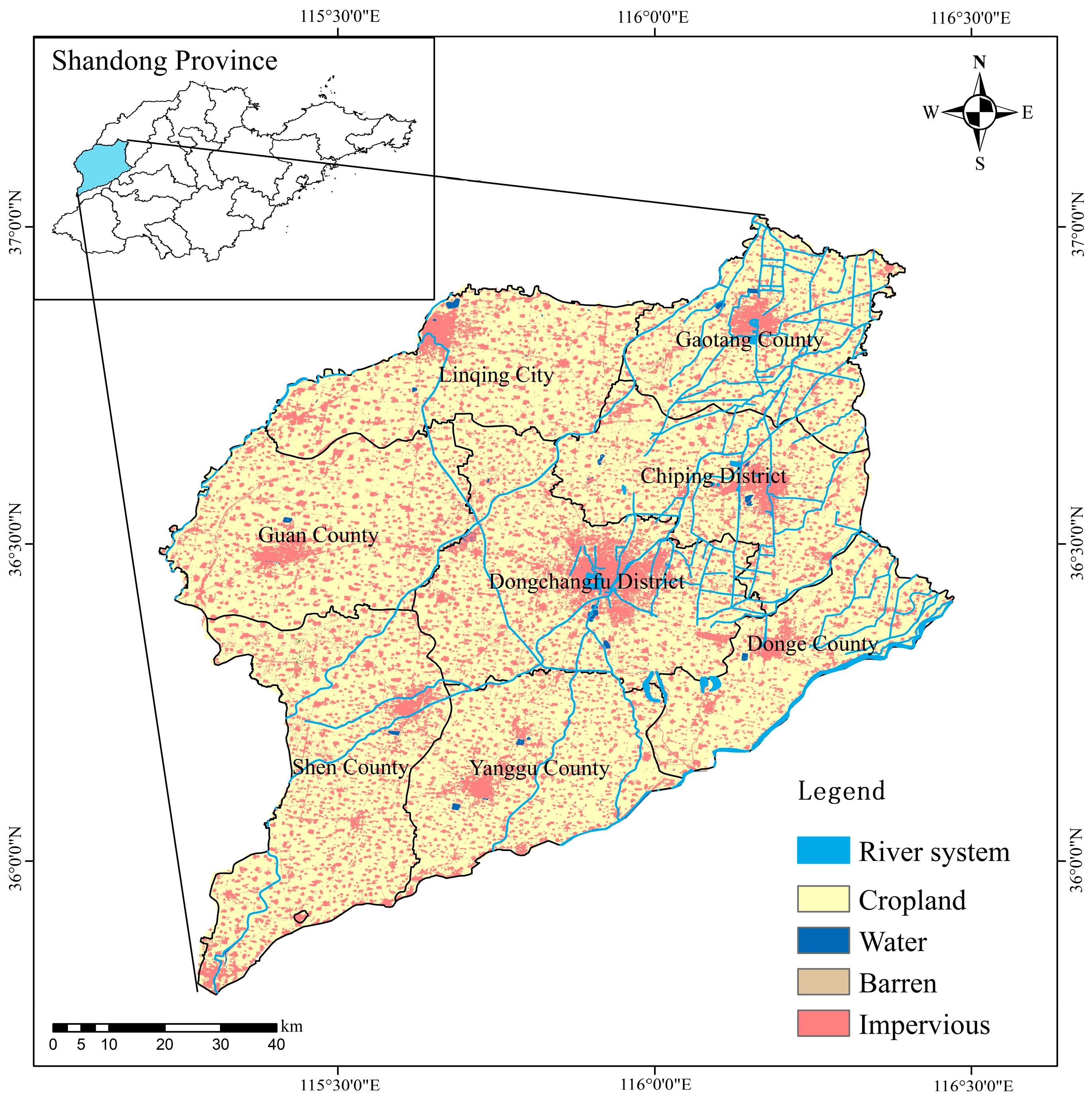

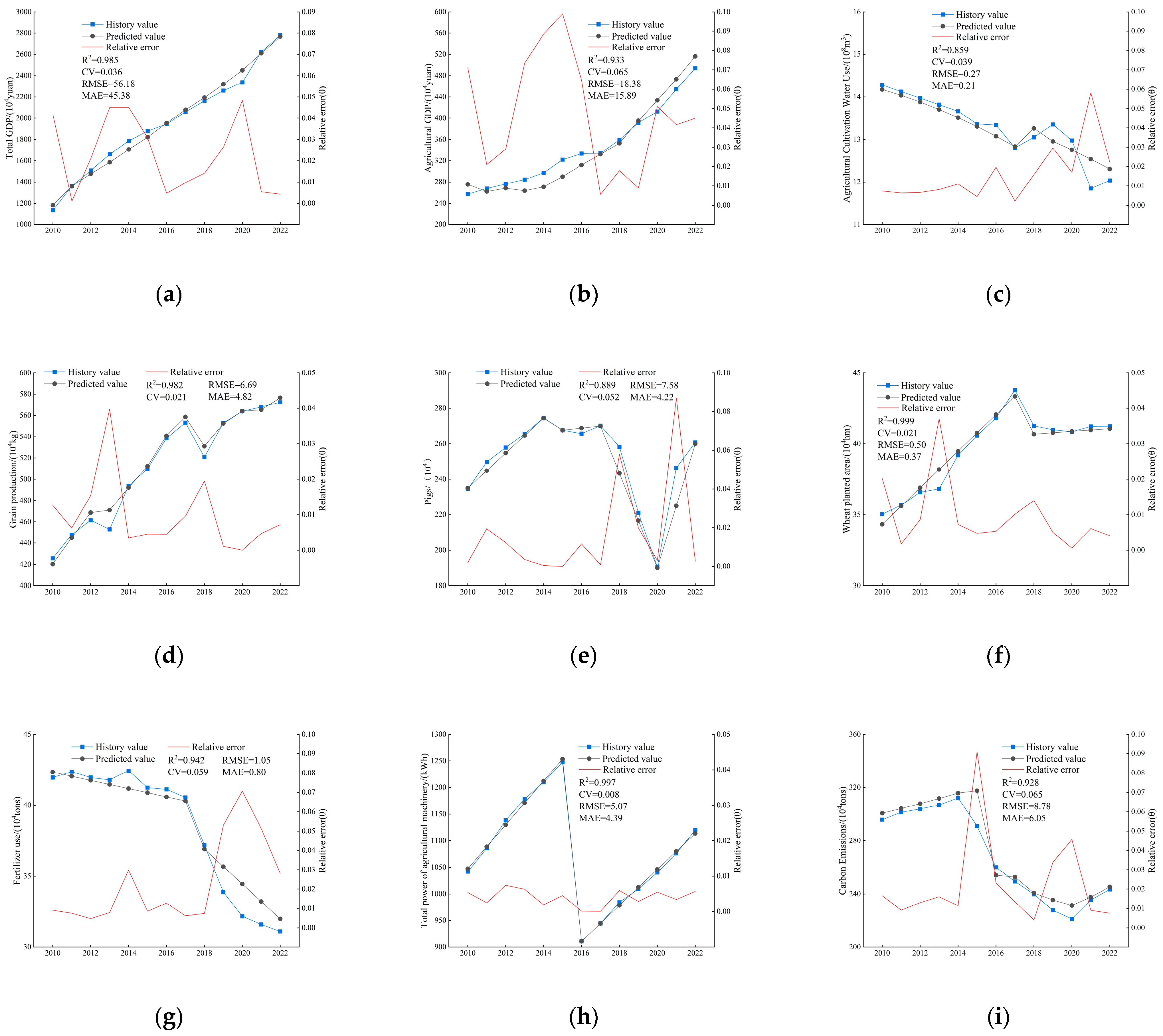
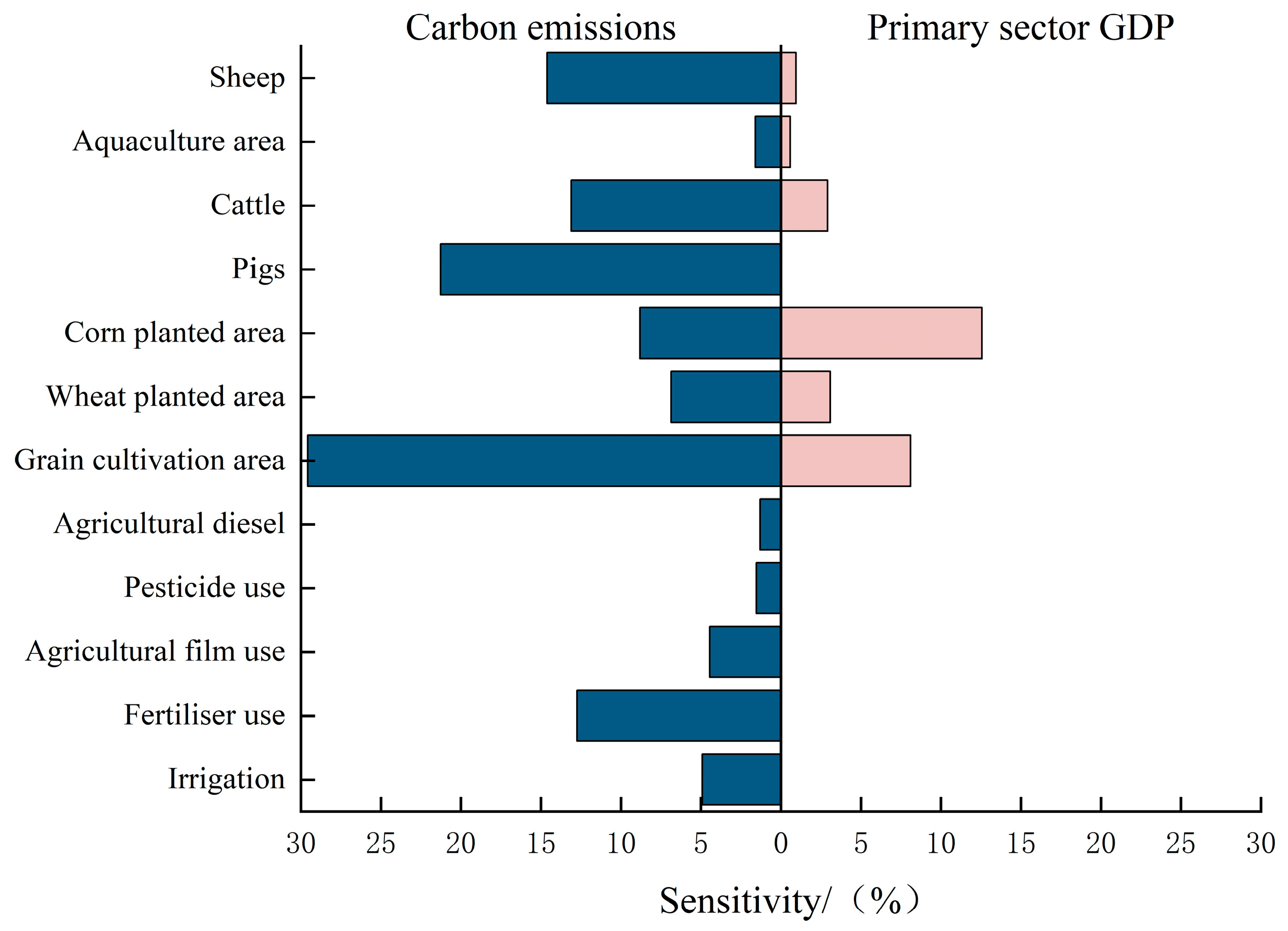
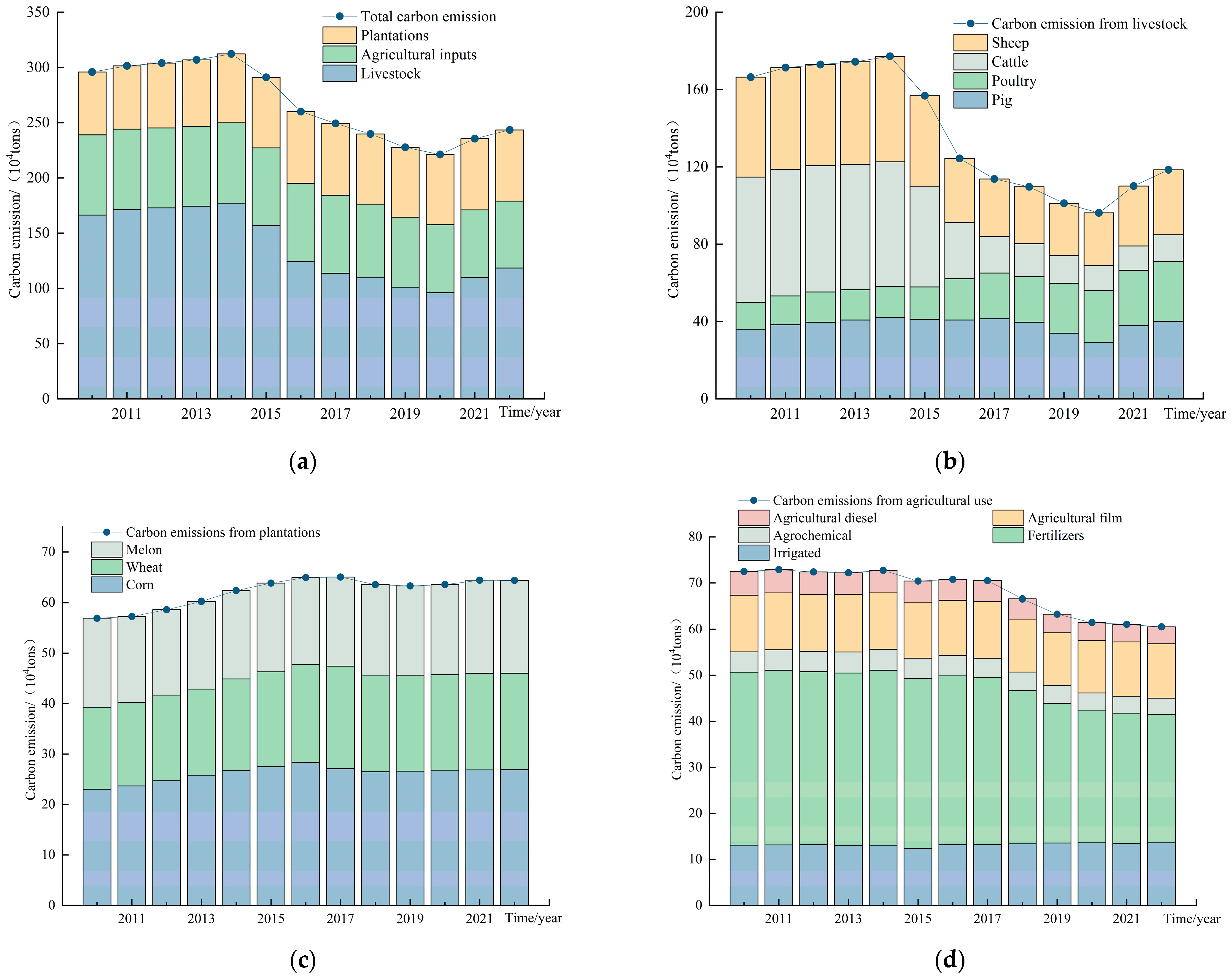
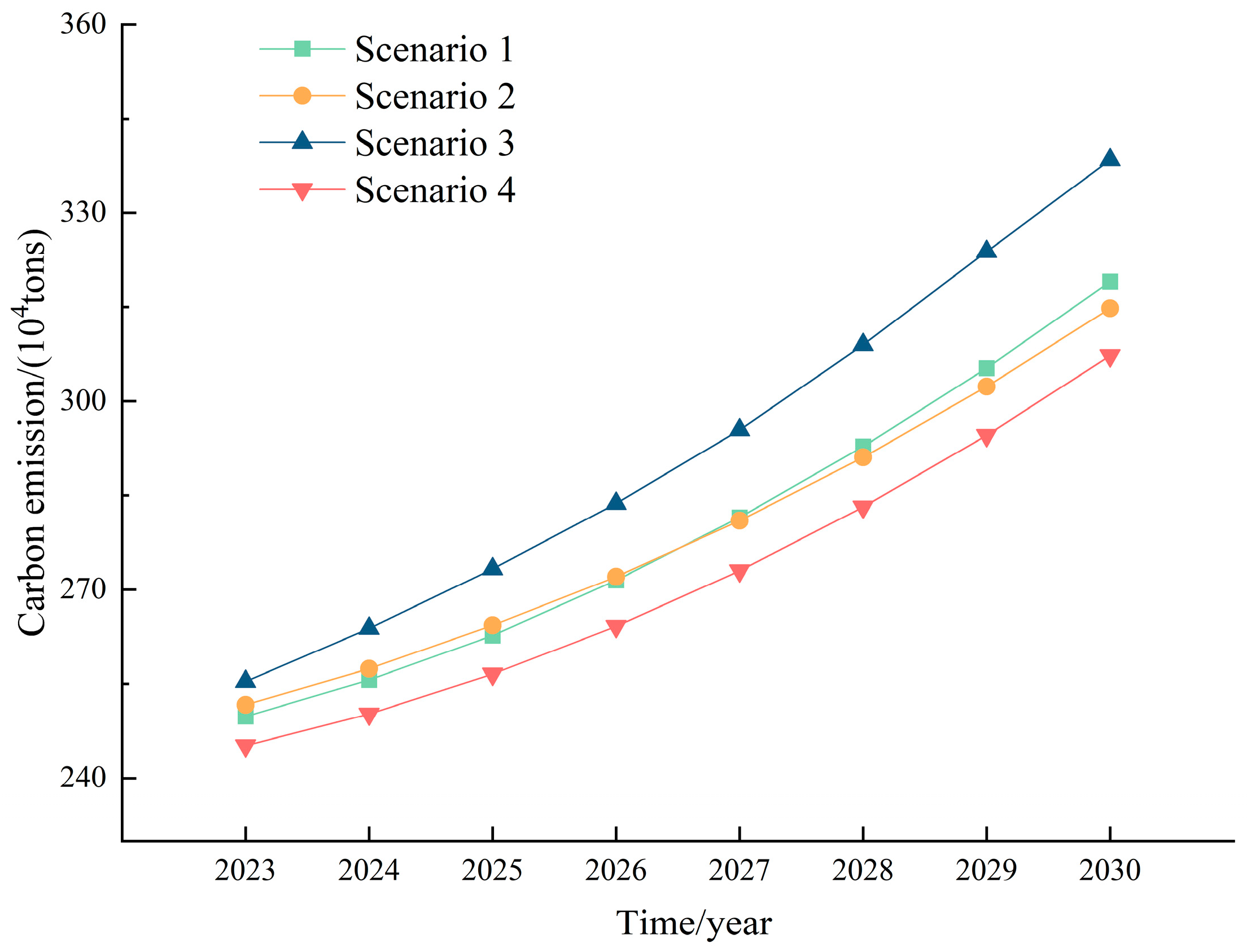
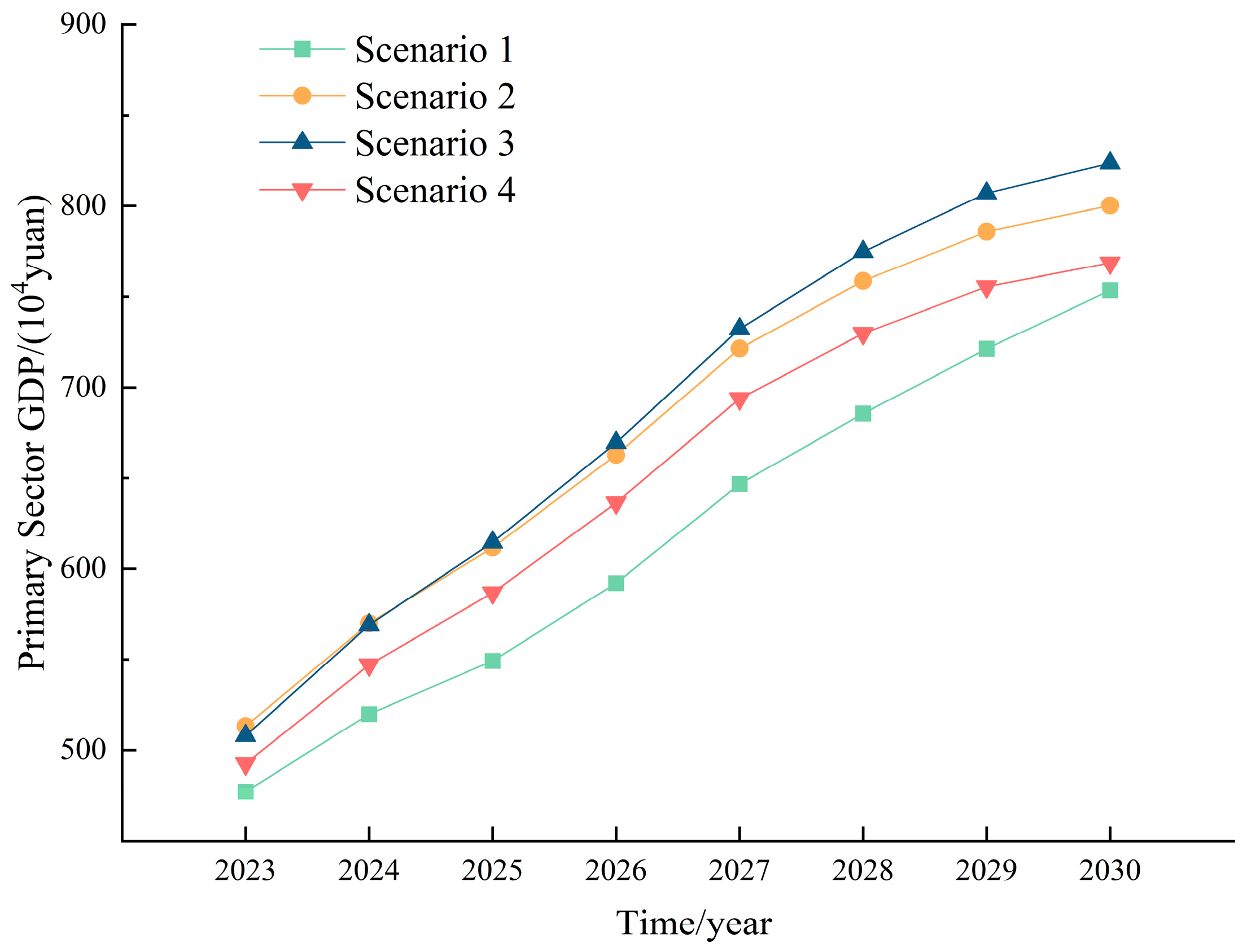
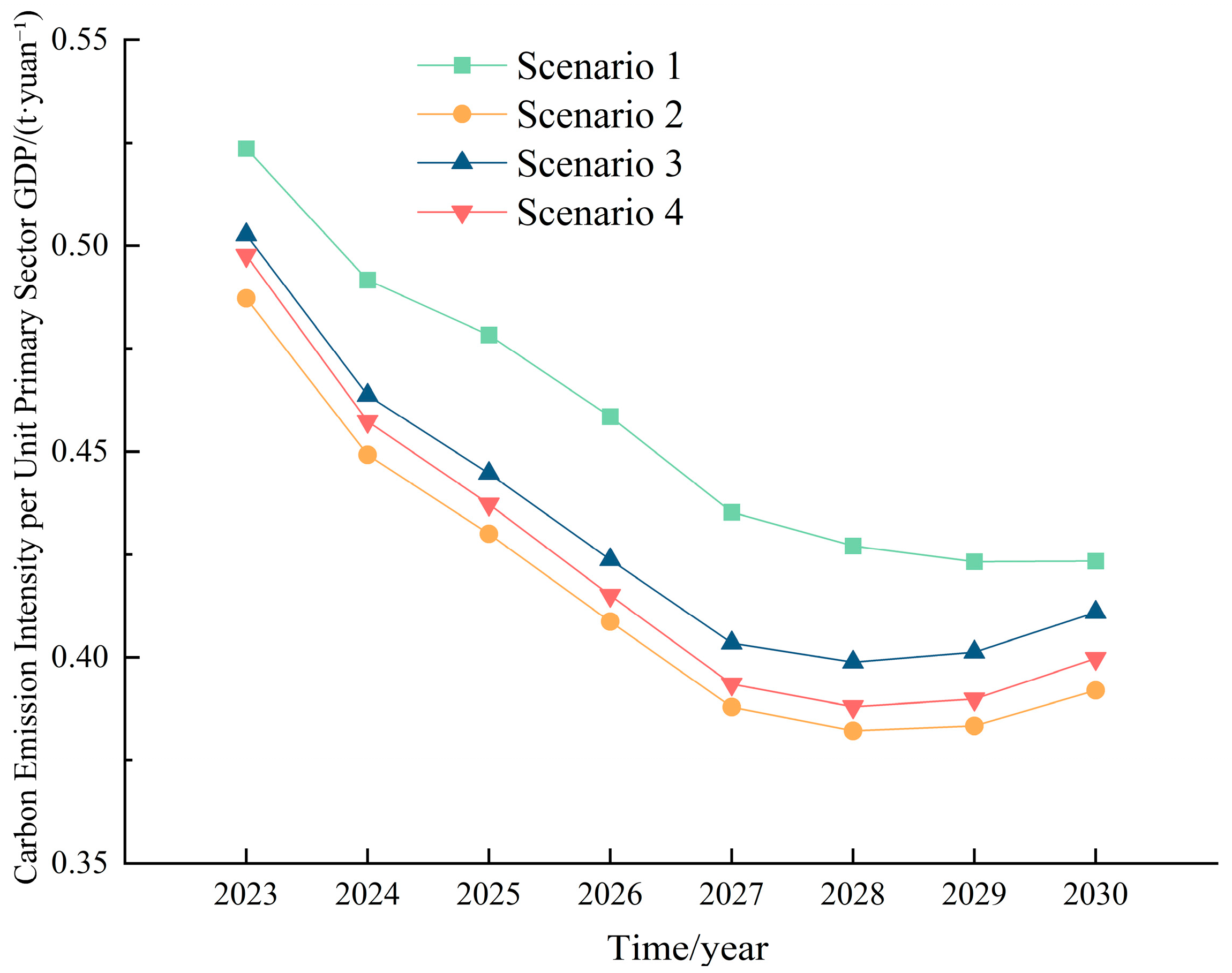
| Type | Official | Significance of Variables |
|---|---|---|
| Carbon emissions from agricultural inputs | CNZ: Total carbon emissions from agricultural inputs; Ci: Carbon emissions by source categories; TNZi: Actual use of each carbon source; : Carbon emission factors by source category. | |
| Carbon emissions from crop cultivation | CZW: Total carbon emissions from cultivation; TZWi: Actual acreage of each crop; : Carbon emission factors by source category. | |
| Carbon emissions from livestock and poultry | CXM: Total carbon emissions from livestock farming; Ni: Average livestock and poultry holdings; : N2O, CH4 emission factor. | |
| Ln: Current year’s output; Sn: Average life cycle, average life cycle of pigs and poultry was set at 200 d and 55 d respectively. | ||
| Carbon emissions from water use | CAW: Carbon emissions from agricultural water use; AW: Agricultural irrigation water; E: Energy intensity of water used for agricultural irrigation, 0.336 kWh/m3; EFCO2: electricity carbon emission factor, 0.801kg/kWh. | |
| Carbon sinks from food crops | CZ: Total crop carbon sequestration; CZi: Carbon sequestration in crops; Ai: carbon sequestration rate; Yi: Crop economic yield; Wi: Crop moisture content; Hi: Crop economy coefficient. |
| Agricultural Material Input | Carbon Emission Coefficient | Reference Source | Farmland Utilization | Carbon Emission Coefficient | Reference Source | ||
| Chemical fertilizer | 0.8956 kg(C)/kg | ORNL | Wheat | 1.75 kg(N2O)/hm2 | [29] | ||
| Pesticides | 4.9341 kg(C)/kg | ORNL | Corn | 2.532 kg(N2O)/hm2 | |||
| Plastic film | 5.18 kg(C)/kg | IREEA | Vegetables | 4.21 kg(N2O)/hm2 | |||
| Agricultural diesel oil | 0.5927 kg(C)/kg | ORNL | - | - | - | ||
| Agricultural irrigation | 266.48 kg(C)/hm2 | - | - | - | - | ||
| Livestock and Poultry Farming | Intestinal Fermentation [kg(CH4)/(head·a)] | Fecal Discharge | Carbon Sinks from Food Crop Production | Carbon Sequestration Rate (Ai) | Economic Factor (Hi) | Moisture Content (Wi) | |
| [kg(CH4)/(head·a)] | [kg(N2O)/(head·a)] | ||||||
| Cattle | 47.00 | 1.00 | 1.39 | Wheat | 0.4853 | 0.434 | 0.12 |
| Sheep | 5.00 | 0.16 | 0.86 | Corn | 0.4709 | 0.438 | 0.13 |
| Pigs | 1.00 | 4.00 | 0.53 | Melons and vegetables | 0.4500 | 0.625 | 0.90 |
| Poultry | - | 0.02 | 0.02 | - | - | - | - |
| Variant | Equation |
|---|---|
| Total water consumption in agriculture | Water use for agricultural cultivation + water use for the rest of agricultural activities |
| AFFL GDP | Agriculture GDP + Forestry GDP + Fisheries GDP + Livestock GDP |
| Agriculture GDP | −3.29978 × 106 − 0.102 * wheat production + 0.274 * maize production + 0.969 * melon production − 5.352 * fruit production |
| Pesticide use | 4689.93 + 6.892 * Grain cultivation area − 236.046 * (Time-2009) |
| Agricultural film usage | 16,130.8 + 11.504 * Grain cultivation area − 278.641 * (Time-2009) |
| Agricultural diesel usage | 93,645.7 − 1440.85 * (Time-2009) − 39.817 * Mechanization level |
| Fertilizer use | 138,642 + 431.705 * Grain cultivation area – 13,058.9 * (Time-2009) |
| Irrigation | 499,613 − 5227.1 * (Time-2009) + 533.098 * (Time-2009) * (Time-2009) |
| Aquaculture area | IF THEN ELSE (Time ≤ 2017, 7336.77 + 400.768 * (Time-2009) − 17.1607 * (Time-2009) * (Time-2009), 19,192.8 − 1823.56 * (Time-2009) + 55.9304 * (Time-2009) * (Time-2009)) |
| Cattle | IF THEN ELSE (Time ≤ 2015, 37.339 + 0.462357 * (Time-2009) − 0.0896429 * (Time-2009) * (Time-2009), 30.7091 − 3.55826 * (Time-2009) + 0.134369 * (Time-2009) * (Time-2009)) |
| Pigs | WITH LOOKUP (Time,([(0,0)–(10,10)],(2010,235),(2014,274.5),(2015,267.67),(2017,270),(2020,190),(2022,260),(2025,280),(2030,330))) |
| Grain cultivation area | IF THEN ELSE (Time ≤ 2017, 23.5314 * Time – 46,608.3, 1.734 * Time − 2693.15) |
| Corn-planted area | 34,310 + 452.637 * Grain cultivation area |
| Melon- and vegetable-planting Area | 156,734 − 1824.15 * (Time-2009) + 248.521 * (Time-2009) * (Time-2009) |
| Wheat production | 688,351 + 4.02 * Wheat acreage + 36,549.5 * (Time-2009) |
| Corn production | −65,383.5 + 6.193 * Maize acreage + 33,056.5 * (Time-2009) |
| Carbon emissions from planting | (Wheat acreage * 1.75 + Corn acreage * 2.532 + Melon acreage * 4.21 + Fruit acreage * 0) * 0.265 |
Disclaimer/Publisher’s Note: The statements, opinions and data contained in all publications are solely those of the individual author(s) and contributor(s) and not of MDPI and/or the editor(s). MDPI and/or the editor(s) disclaim responsibility for any injury to people or property resulting from any ideas, methods, instructions or products referred to in the content. |
© 2025 by the authors. Licensee MDPI, Basel, Switzerland. This article is an open access article distributed under the terms and conditions of the Creative Commons Attribution (CC BY) license (https://creativecommons.org/licenses/by/4.0/).
Share and Cite
Yuan, W.; Wang, H.; Liu, Y.; Han, S.; Cong, X.; Xu, Z. Simulation of Water–Energy–Food–Carbon Nexus in the Agricultural Production Process in Liaocheng Based on the System Dynamics (SD). Sustainability 2025, 17, 6607. https://doi.org/10.3390/su17146607
Yuan W, Wang H, Liu Y, Han S, Cong X, Xu Z. Simulation of Water–Energy–Food–Carbon Nexus in the Agricultural Production Process in Liaocheng Based on the System Dynamics (SD). Sustainability. 2025; 17(14):6607. https://doi.org/10.3390/su17146607
Chicago/Turabian StyleYuan, Wenshuang, Hao Wang, Yuyu Liu, Song Han, Xin Cong, and Zhenghe Xu. 2025. "Simulation of Water–Energy–Food–Carbon Nexus in the Agricultural Production Process in Liaocheng Based on the System Dynamics (SD)" Sustainability 17, no. 14: 6607. https://doi.org/10.3390/su17146607
APA StyleYuan, W., Wang, H., Liu, Y., Han, S., Cong, X., & Xu, Z. (2025). Simulation of Water–Energy–Food–Carbon Nexus in the Agricultural Production Process in Liaocheng Based on the System Dynamics (SD). Sustainability, 17(14), 6607. https://doi.org/10.3390/su17146607






